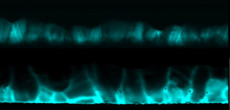Atomic Swtcheroo Explains Origins of aThin-film Solar Cell Mystery
Simulations Reveal Detailed Physics for First Time
April 29, 2014

Cross-sectional electron beam-induced current maps show the difference in cadmium telluride solar cells before (pictured above) and after (below) cadmium chloride treatment. The increased brightness after treatment indicates higher current collection at the grain boundaries.
Scientists have known since the 1980s that treating cadmium-telluride (CdTe) solar cell materials with cadmium-chloride improves efficiency, but the underlying physics have remained a mystery until now. Combining electron microscopy with computer simulations run at the Department of Energy’s National Energy Research Scientific Computing Center (NERSC), researchers have put this decades long debate to rest.
Beyond providing a long-awaited explanation, however, this finding could lead to a less-expensive, more easily fabricated, thin-film alternative to silicon-based photovoltaics.
Thin-film CdTe solar cells are considered a potential rival to silicon-based photovoltaic systems because of their theoretically low cost per power output and ease of fabrication. Their comparatively low historical efficiency in converting sunlight into energy, however, has limited the technology’s widespread use, especially for home systems.
Research in the 1980s showed that treating CdTe thin films with cadmium-chloride significantly raises the cell’s efficiency, but scientists have been unable to determine the underlying causes. The answer lay in investigating the material at an atomic level, said Chen Li, a researcher from Oak Ridge National Laboratory (ORNL) who led this recent study. “We knew that chlorine was responsible for this magical effect, but we needed to find out where it went in the material’s structure,” said Li.
By comparing the solar cells before and after chlorine treatment, the researchers realized that “grain boundaries” were implicated in the enhanced performance. Grain boundaries are tiny defects that normally act as roadblocks to efficiency because they inhibit carrier collection, which greatly reduces solar cell power.
Using electron microscopy techniques to study the thin films’ structure and chemical composition before and after treatment, the researchers found that chlorine atoms replaced tellurium atoms within the grain boundaries.
With a clearer picture of the material’s atomic structure, the team was able to construct computer models and calculate what was happening in the material.
“We calculated the electronic properties of the system containing the unit of the grain boundary, first without any chlorine to make sure our models were correct, and then with differing amounts of chlorine,” said Yanfa Yan of the University of Toledo, who led the density functional theory (DFT) calculations performed on NERSC’s Cray XT6 system, Hopper.
His calculations revealed that this atomic substitution, chlorine for tellurium, creates local electric fields at the grain boundaries that boost the material’s photovoltaic performance instead of damaging it.
“This grain boundary model has been proposed by others, but there wasn’t any theoretical understanding or experimental evidence to support it from the atomic scale,” said Yan. “The calculations we performed at NERSC were critical to this result.”
The research team’s finding, in addition to providing a long-awaited explanation, could be used to guide engineering of higher-efficiency CdTe solar cells. Controlling the grain boundary structure, says Li, is a new direction that could help raise the cell efficiencies closer to the theoretical maximum of 32 percent light-to-energy conversion. Currently, the record CdTe cell efficiency is only 20.4 percent.
“We think that if all the grain boundaries in a thin film material could be aligned in the same direction, it could improve cell efficiency even further,” Li said.
The team’s research appeared as “Grain-Boundary-Enhanced Carrier Collection in CdTe Solar Cells,” in Physical Review Letters on April 16.
This article was adapted from an ORNL press release.
About Computing Sciences at Berkeley Lab
High performance computing plays a critical role in scientific discovery. Researchers increasingly rely on advances in computer science, mathematics, computational science, data science, and large-scale computing and networking to increase our understanding of ourselves, our planet, and our universe. Berkeley Lab’s Computing Sciences Area researches, develops, and deploys new foundations, tools, and technologies to meet these needs and to advance research across a broad range of scientific disciplines.







 Instagram
Instagram YouTube
YouTube